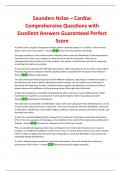Saunders Nclex – Cardiac
Comprehensive Questions with
Excellent Answers Guaranteed Perfect
Score
A chaotic small, irregular, disorganized cardiac pattern suddenly appears on a client's cardiac monitor.
Which is the nurse's first action? - Answer -Check the client and the chest leads.
This type of pattern on the cardiac monitor indicates either ventricular fibrillation or lead displacement.
The first action of the nurse is always to check the client and the chest leads. If the client is
nonresponsive and the leads are not the problem, then option 4 would be the next choice, along with
contacting the health care provider.
A client has been admitted with left-sided heart failure. When planning care for the client, interventions
should be focused on reduction of which specific problem associated with this type of heart failure? -
Answer -Bilateral lung crackles
The client with heart failure may present with different symptoms, depending on whether the right or
the left side of the heart is failing. Adventitious breath sounds, such as crackles, are an indicator of
decreased left-sided heart function. Peripheral edema, jugular vein distention, and ascites all can be
present because of insufficiency of the pumping action of the right side of the heart.
A client has developed uncontrolled atrial fibrillation with a ventricular rate of 150 beats/min. What
manifestation should the nurse observe for when performing the client's focused assessment? -
Answer -Hypotension and dizziness
The client with uncontrolled atrial fibrillation with a ventricular rate greater than 100 beats/min is at risk
for low cardiac output due to loss of atrial kick. The nurse assesses the client for palpitations, chest pain
or discomfort, hypotension, pulse deficit, fatigue, weakness, dizziness, syncope, shortness of breath, and
distended neck veins.
A client has received antidysrhythmic therapy for the treatment of premature ventricular contractions
(PVCs). The nurse evaluates this therapy as most effective if the client's PVCs continued to exhibit which
finding? - Answer -Decrease to a frequency of less than 6 per minute
PVCs are considered dangerous when they are frequent (more than 6 per minute), occur in pairs or
couplets, are multifocal (multiform), or fall on the T wave. In each of these instances, the client's cardiac
rhythm is likely to degenerate into ventricular tachycardia or ventricular fibrillation, both of which are
potentially deadly dysrhythmias.
A client is having frequent premature ventricular contractions. The nurse should place priority on
assessment of which item? - Answer -Blood pressure and oxygen saturation
, Premature ventricular contractions can cause hemodynamic compromise. Therefore, the priority is to
monitor the blood pressure and oxygen saturation. The shortened ventricular filling time can lead to
decreased cardiac output. The client may be asymptomatic or may feel palpitations. Premature
ventricular contractions can be caused by cardiac disorders, states of hypoxemia, or by any number of
physiological stressors, such as infection, illness, surgery, or trauma, and by intake of caffeine, nicotine,
or alcohol.
A client recovering from an exacerbation of left-sided heart failure is experiencing activity intolerance.
Which change in vital signs during activity would be the best indicator that the client is tolerating mild
exercise? - Answer -Respiratory rate increased from 16 to 19 breaths per minute.
Vital signs that remain near baseline indicate good cardiac reserve with exercise. Only the respiratory
rate remains within the normal range. Additionally, it reflects a minimal increase. A pulse rate increase to
a rate over 100 beats per minute during mild exercise does not show tolerance, nor does a 5% decrease
in oxygen saturation levels. In addition, blood pressure decreasing by more than 10 mm Hg is not a sign
indicating tolerance of activity.
A client with a first-degree heart block has an electrocardiogram (ECG) taken during an episode of chest
pain. The nurse knows that which ECG finding would be an indication of first-degree heart block? -
Answer -Prolonged PR interval
A prolonged PR interval indicates first-degree heart block. The development of Q waves indicates
myocardial necrosis. Tall, peaked T waves may indicate hyperkalemia. A widened QRS complex indicates
a delay in intraventricular conduction, such as bundle branch block. An ECG taken during a pain episode
is intended to capture ischemic changes, which also include ST-segment elevation or depression.
A client with angina has a 12-lead electrocardiogram taken during an episode of chest pain. The nurse
should examine the tracing for which electrocardiographic (ECG) change caused by myocardial ischemia?
- Answer -ST segment elevation or depression
An electrocardiogram taken during a chest pain episode captures ischemic changes, which include ST
segment elevation or depression. Tall, peaked T waves may indicate hyperkalemia. A prolonged PR
interval indicates first-degree heart block. A widened QRS complex indicates delay in intraventricular
conduction, such as a bundle branch block.
A client with myocardial infarction is experiencing new, multiform premature ventricular contractions
(PVCs). Knowing that the client is allergic to lidocaine hydrochloride, the nurse plans to have which
medication available for immediate use? - Answer -ProcainamideProcainamide is an
antidysrhythmic that may be used to treat ventricular dysrhythmias in clients who are allergic to
lidocaine. Digoxin is a cardiac glycoside; verapamil is a calcium-channel blocking agent; metoprolol is a β-
adrenergic blocking agent.
A client with rapid-rate atrial fibrillation asks a nurse why the health care provider is going to perform
carotid sinus massage. Which is a correct explanation? - Answer -The vagus nerve slows the heart
rate.
Carotid sinus massage is one maneuver used for vagal stimulation to decrease a rapid heart rate and
possibly terminate a tachydysrhythmia. Others include inducing the gag reflex and asking the client to




